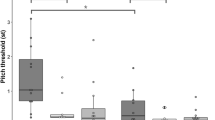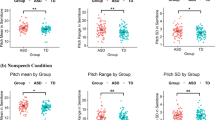Abstract
This study investigated whether intonation deficits were observed in 19 Cantonese-speaking adults with high-functioning autism (HFA) when compared to 19 matched neurotypical (NT) controls. This study also investigated the use of sentence-final particles (SFPs) and their relationship with intonation in both groups. Standard deviations (SDs) of the fundamental frequency (F0), the total number and the type of SFPs were calculated based on narrative samples. The HFA group demonstrated significantly higher SD of F0 and a positive correlation between the type of SFPs and SD of F0. Both groups produced a similar total number and type of SFPs. The results supported the universality of atypical intonation in ASD. The relationship between intonation and SFPs could be further explored by focusing on sentences containing SFPs.
Similar content being viewed by others
References
Amoroso, H. (1992). Disorder of vocal signaling in children. In H. Papiusek, U. Jurgens, & M. Papousek (Eds.), Nonverbal vocal communication: Comparative and developmental approaches (pp. 192–204). Cambridge: Cambridge University Press.
Arciuli, J. (2014). Prosody and autism. In J. Arciuli & J. Brock (Eds.), Communication in autism (pp. 103–122). Amsterdam, NLD: John Benjamins Publishing Company.
Baltaxe, C. A. M., & Simmons, J. Q. (1985). Prosodic development in normal and autistic children. In E. Schopler & G. B. Mesibov (Eds.), Communication problems in autism (pp. 95–125). New York: Plenum Press.
Baltaxe, C. A. M., Simmons, J. Q., & Zee, E. (1984a). Intonation patterns in normal, autisitic and aphasic children. In A. Cohen & M. van de Broecke (Eds.), Proceedings of the 10th international Congress of Phonetic Sciences (pp. 713–718). Dordrecht: Foris.
Baltaxe, C. A. M., Simmons, J. Q., & Zee, E. (1984). Intonation patterns in normal, autisitic and aphasic children. In A. Cohen, & M. van de Broecke (Eds.), Proceedings of the 10th international congress of phonetic sciences (pp. 713–718). Dordrecht: Foris.
Baron-Cohen, S. (1995). Mindblindness: An essay on autism and theory of mind. Cambridge, MA: MIT Press.
Baron-Cohen, S., Wheelwright, S., Skinner, R., Martin, J., & Clubley, E. (2001). The autism spectrum quotient (AQ): Evidence from Asperger syndrome/high-functioning autistic males and females, scientists and mathematicians. Journal of Autism & Development Disorders, 31, 5–17.
Bauer, R. S., & Benedict, P. K. (1997). Modern Cantonese phonology. Berlin: Mouton deGruyter.
Boersma, P., & Weenink, D. (2005). PRAAT: Doing phonetics by computer (Version 4.3.14). Retrieved from http://www.praat.org.
Chan, M. K. M. (1996). Gender-marked speech in Cantonese: The case of sentence-final particles je and jek. Studies in the Linguistic Sciences, 26, 1–38.
Chao, Y. R. (1968). A grammar of spoken Chinese. Berkeley, CA: University of California Press.
Cheung, K. H. (1986). The phonology of present-day Cantonese. Doctoral Dissertation. London: University College.
Crystal, D. (1987). The Cambridge encyclopedia of language. Cambridge: Cambridge University Press.
Cutler, A., & Isard, S. D. (1980). The production of prosody. In B. Butterworth (Ed.), Language production (Vol. 1, pp. 245–269). London: Academic Press.
Diehl, J., & Berkovits, L. D. (2010). Is prosody a diagnostic and cognitive bellwether of autism spectrum disorders? In A. Harrison (Ed.), Speech disorders: causes, treatment and social effects. New York: Nova Science Publishers Inc.
Diehl, J., Watson, D., Bennetto, L., Mcdonough, J., & Gunlogson, C. (2009). An acoustic analysis of prosody in high-functioning autism. Applied Psycholinguistics, 30, 385–404.
Fay, W., & Schuler, A. L. (1980). Emerging language in autistic children. Baltimore, MD: University Park Press.
Fosnot, S. M., & Jun, S. (1999). Prosodic characteristics in children with stuttering or autism during reading and imitation. Paper presented at the 14th international congress of phonetic sciences.
Fox, A., Luke, K. K., & Nancarrow, O. (2008). Aspects of intonation in Cantonese. Journal of Chinese Linguistics, 36, 321–367.
Green, H., & Tobin, Y. (2009). Prosodic analysis is difficult… but worth it: A study in high functioning autism. International Journal of Speech-Language Pathology, 11, 308–315.
Happé, F. G. E. (1994). An advanced test of theory of mind: Understanding of story characters’ thoughts and feelings by able autistic, mentally handicapped, and normal children and adults. Journal of Autism and Developmental Disorders, 24, 129–154.
Hubbard, K., & Trauner, D. (2007). Intonation and emotion in autistic spectrum disorders. Journal of Psycholinguistic Research, 36, 159–173.
Kleinman, J., Marciano, P. L., & Ault, R. L. (2001). Advanced theory of mind in high-functioning adults with autism. Journal of Autism and Developmental Disorders, 31, 29–36.
Kwok, H. (1984). Sentence particle in Cantonese. Hong Kong: Centre of Asian Studies, The University of Hong Kong.
Lane, H., Wozniak, J., Matthies, M., Svirsky, M., Perkell, J., O’Connell, M., & Manzella, J. (1997). Changes in sound pressure and fundamental frequency contours following changes in hearing status. Journal of the Acoustic Society of America, 101, 2244–2252.
Law, S. P. (1990). The syntax and phonology of Cantonese sentence-final particles. Doctoral Dissertation. Boston, MA: Boston University.
Lee, H. T., & Law, A. (2001). Epistemic modality and the acquisition of Cantonese final particles. In M. Nakayama (Ed.), Issues in East Asian language acquisition (pp. 67–128). Tokyo: Kuroshio Publishers.
Leung, C. S. (2005). A study of the utterance particles in Cantonese as spoken in Hong Kong. Hong Kong: Language Information Science Research Centre City University of Hong Kong.
Li, J. P. W., Law, T., Lam, G. Y. H., & To, C. K. S. (2013). Role of sentence final particles and prosodic cues in irony comprehension in Cantonese-speaking Children with and without ASD. Clinical Linguistics & Phonetics, 27(1), 18–32.
Lord, C., Rutter, M., DiLavore, P. C., Risi, S., Gotham, K., & Bishop, S. (2012). Autism diagnostic observation schedule (2nd ed.). Torrance, CA: Western Psychological Services.
Lord, C., Rutter, M., & Lecouteur, A. (1994). Autism diagnostic interview—Revised—A revised version of a diagnostic interview for caregivers of individuals with possible pervasive developmental disorders. Journal of Autism and Developmental Disorders, 24, 659–685.
Luke, K. K. (1990). Utterance particles in Cantonese conversation. Amsterdam: John Benjamins.
Ma, J. K.-Y., Ciocca, V., & Whitehill, T. L. (2006). Effect of intonation on Cantonese lexical tones. Journal of the Acoustical Society of America, 120(6), 3978–3987.
Matthews, S., & Yip, V. (1994). Cantonese: A comprehensive grammar. London: Routledge.
McCann, J., & Peppé, S. (2003). Prosody in autism spectrum disorders: a critical review. International Journal of Language & Communication Disorders, 38(4), 325–350.
McCann, J., Peppé, S., Gibbon, F. E., O’Hare, A., & Rutherford, M. (2007). Prosody and its relationship to language in school-aged children with high-functioning autism. International Journal of Language & Communication Disorders, 42, 682–702.
Mok, P., & Dellwo, V. (2008). Comparing native and non-native speech rhythm using acoustic rhythmic measures: Cantonese, Beijing Mandarin and English. In Proceedings of the 4th speech prosody (pp. 423–426). Campinas, Brazil.
Nadig, A., & Shaw, H. (2012). Acoustic and perceptual measurement of expressive prosody in high-functioning autism: Increased pitch range and what it means to listeners. Journal of Autism and Developmental Disorders, 42, 499–511.
Nakai, Y., Takashima, R., Takiguchi, T., & Takada, S. (2014). Speech intonation in children with autism spectrum disorder. Brain & Development, 36, 516–522.
Paul, R., Bianchi, N., Augustyn, A., Klin, A., & Volkmar, F. (2008). Production of syllable stress in speakers with autism spectrum disorders. Research in Autism Spectrum Disorders, 2, 110–124.
Peppé, S., McCann, J., Gibbon, F., O’Hare, A., & Rutherford, M. (2007). Receptive and expressive prosodic ability in children with high-functioning autism. Journal of Speech, Language, and Hearing Research, 50(4), 1015–1028.
Russo, N., Larson, C., & Kraus, N. (2008). Audio-vocal system regulation in children with autism spectrum disorders. Experimental Brain Research, 188, 111–124.
Rutherford, M. D., Baron-Cohen, S., & Wheelwright, S. (2002). Reading the mind in the voice: A study with normal adults and adults with Asperger syndrome and high functioning autism. Journal of Autism and Developmental Disorders, 32, 189–194.
Rutter, M., LeCouteur, A., & Lord, C. (2003). Autism diagnostic interview—Revised. Los Angeles: Western Psychological Services.
Sharda, M., Subhadra, T. P., Sahay, S., Nagaraja, C., Singh, L., Mishra, R., et al. (2010). Sounds of melody-pitch patterns of speech in autism. Neuroscience Letters, 478(1), 42–45. doi:10.1016/j.neulet.2010.04.066.
Shriberg, L. D., Paul, R., McSweeny, J. L., Klin, A., Cohen, D. J., & Volkmar, F. R. (2001). Speech and prosody characteristics of adolescents and adults with high-functioning autism and Asperger syndrome. Journal of Speech, Language, and Hearing Research, 44, 1097–1115.
T’sou, B., Lee, T., Tung, P., Chan, A., Man, Y., & To, C. (2006). Hong Kong Cantonese Oral language assessment scale. Hong Kong: Language Information Sciences Research Centre.
van Santen, J. P., Prud’hommeaux, E. T., & Black, L. M. (2009). Automatic assessment of prosody production. Speech Communication, 51, 1082–1097.
Yau, S. (1980). Sentential connotations in Cantonese. Fangyan, 1, 35–52.
Yip, M. (2002). Tone. Cambridge: Cambridge University Press.
Yu, L., Fan, Y. B., Deng, Z., Huang, D., Wang, S., & Zhang, Y. (2015). Pitch processing in tonal-language-speaking children with autism: An event-related potential study. Journal of Autism and Developmental Disorders, 45, 3656–3667.
Acknowledgments
This study was partly supported by Small Project Funding, The University of Hong Kong (201209176020) awarded to Carol K. S. To. We thank all the participants in the project.
Author Contributions
CT conceived of the study, interpreted the data, drafted the manuscript; KC participated in the analysis and interpretation of the data and draft the manuscript. Both authors read and approved the final manuscript.
Author information
Authors and Affiliations
Corresponding author
Rights and permissions
About this article
Cite this article
Chan, K.K.L., To, C.K.S. Do Individuals with High-Functioning Autism Who Speak a Tone Language Show Intonation Deficits?. J Autism Dev Disord 46, 1784–1792 (2016). https://doi.org/10.1007/s10803-016-2709-5
Published:
Issue Date:
DOI: https://doi.org/10.1007/s10803-016-2709-5




